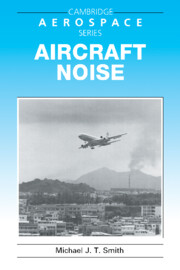Book contents
- Frontmatter
- Contents
- Preface
- Acknowledgments
- 1 Human reaction to aircraft noise
- 2 Action against aircraft noise
- 3 Aircraft noise sources
- 4 Power-plant noise control
- 5 Concorde – a special case
- 6 Noise data acquisition and presentation
- 7 Aircraft noise prediction
- 8 Prospects for the future
- 9 Review
- Appendices
- References
- Index
1 - Human reaction to aircraft noise
Published online by Cambridge University Press: 06 November 2009
- Frontmatter
- Contents
- Preface
- Acknowledgments
- 1 Human reaction to aircraft noise
- 2 Action against aircraft noise
- 3 Aircraft noise sources
- 4 Power-plant noise control
- 5 Concorde – a special case
- 6 Noise data acquisition and presentation
- 7 Aircraft noise prediction
- 8 Prospects for the future
- 9 Review
- Appendices
- References
- Index
Summary
Noise, litter, housing and road development, local lighting, crime and a miscellany of other factors all produce mixed emotional reactions in Homo sapiens. Noise has often been cited as the most undesirable feature of life in the urban community. Aircraft noise is second only to traffic noise in the city in its unsociable levels, frequency and time of occurrence, and is often at the top of the list in rural areas. The rapid spread of civil aviation, from the early “jet set” élite of the 1960s to the tourists of today, has only served to intensify the problem, in that the increased number of flights in and out of airports has given rise to much greater intrusion on community life and, hence, to “noise exposure”.
The growth of the jet-powered fleet is outlined in Figure 1.1. Following the initial surge of purchases in the late 1950s and throughout the 1960s, fleet expansion steadied at about 5% per annum in the 1970s. Because aircraft have grown considerably in carrying capacity, the expansion rate since 1980 has declined to about 2–3%, but this rate is expected to be maintained to the end of this century. Although, in general, aircraft have become progressively quieter since the introduction of the bypass and turbofan engines in the 1960s and 1970s, the reduction in the noise level has not sufficiently offset the increase in operations or their psychological impact to bring an end to the problem.
Although levels of noise “exposure” can be quantified in terms of physical variables, each person's reaction to noise depends on his or her tolerance level.
- Type
- Chapter
- Information
- Aircraft Noise , pp. 1 - 19Publisher: Cambridge University PressPrint publication year: 1989
- 2
- Cited by



